Solar photovoltaic is the fastest-growing source of electricity in the world.
Brazil is one of the sunniest countries on the planet and has a unique opportunity to become a global leader in solar photovoltaic energy.
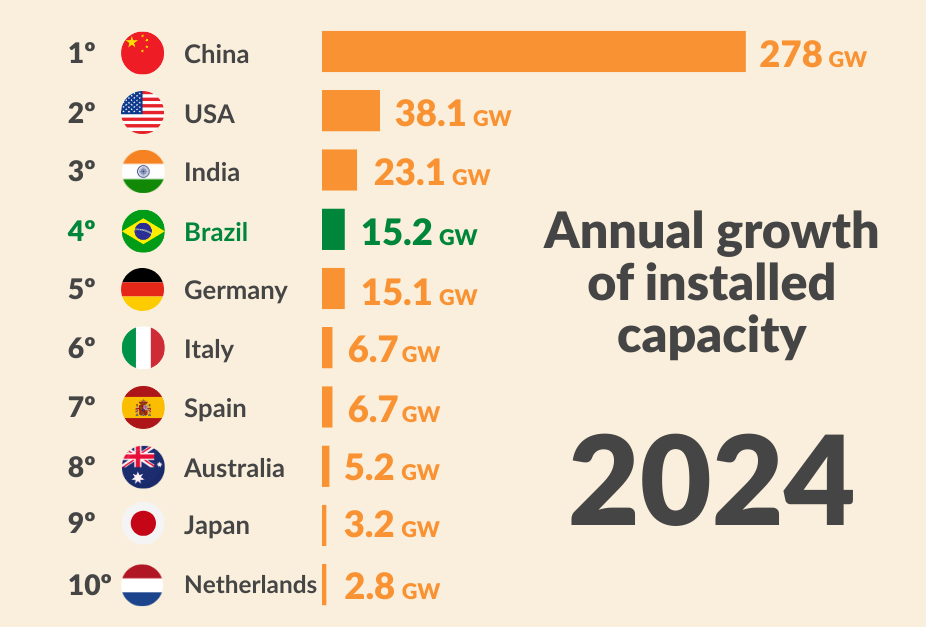
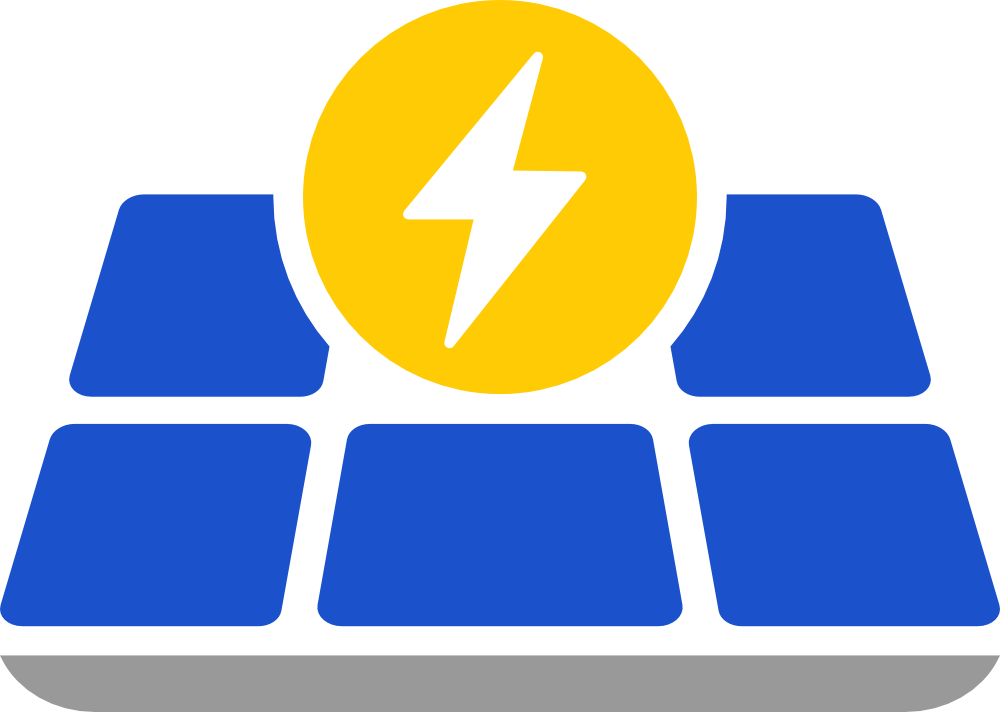
A trajetória do sol no Brasil

2013
- Foundation of ABSOLAR, which begins to represent all segments of Brazil’s solar photovoltaic sector.

2014
- ABSOLAR collaborates with BNDES to develop criteria for financing solar photovoltaic energy.
- Brazil holds its first successful federal solar energy auction, with over 1 GW contracted.
Ver Mais

2015
- Publication of ICMS Agreement No. 16/2015 by Confaz, with ABSOLAR coordination for the adhesion of more states.
- Advocacy for improvements to Aneel Normative Resolution No. 482/2012, leading to the approval of Resolution No. 687/2015.
- Support for the approval of Law No. 13.169/2015, exempting distributed generation energy from PIS/PASEP and COFINS.
- Two federal solar energy auctions contracting an additional 2 GW.
- Co-founding of the Global Solar Council (GSC) and engagement for Brazil to join the International Solar Alliance.
Ver Mais

2016
- Expansion of TUSD and TUST discounts for solar power plants up to 300 MW.

2017
- Improves financing conditions for the solar sector from BNDES.
- State law approved in Minas Gerais granting ICMS exemption for all tariff components and distributed generation modalities up to 5 MW.
- ABSOLAR elected co-chair of the Global Solar Council (GSC).
Ver Mais

2018
- ABSOLAR achieves nationwide adoption of ICMS Agreement No. 16/2015.
- Advocacy for Brazil’s accession to the International Renewable Energy Agency (IRENA).
- Conducting Solar energy auctions in both Regulated (ACR) and Free (ACL) Contracting Environments.
- Inclusion of solar sources in the financing lines of the BNDES Climate Fund and Finame Program and coordination and launch of credit lines from constitutional funds for individuals.
- Launch of the “IPTU Amarelo” in Salvador.
Ver Mais

2019
- Launch of a state-level solar energy PPP in partnership with the state of Piauí.
- Solar energy becomes the most competitive source in energy auctions in Brazil.
- Structuring and launching new conditions for accrediting photovoltaic systems with BNDES.
- Expanding access to financing lines under the Safra Plan for solar photovoltaics.
- Initiation of Bill No. 5,829/2019 to support distributed generation.
- Strong advocacy against Aneel’s proposal “Alternative 5” affecting distributed solar generation.
Ver Mais

2020
- ABSOLAR supports the sector in facing the impacts of the COVID-19 pandemic.
- Inclusion of solar energy in the “Mais Luz para a Amazônia” and “Casa Verde e Amarela” programs.
- Commissioning of a study for the integration of energy storage in Brazil.
- Increase in funding for solar energy through the Safra Plan.
Ver Mais

2021
- Advocacy for the development of the legal framework for renewable distributed generation and collaboration for progress on Bill No. 5,829/2019.
- Engagement with the Ministry of Agriculture, Livestock and Supply to expand credit access for rural solar energy projects.
- Update of Inmetro’s technical requirements and testing for the solar sector.
Ver Mais

2022
- Approval of Law No. 14,300/2022, establishing the legal framework for renewable distributed generation.
- Incorporation of synergistic technologies into ABSOLAR’s bylaws, including energy storage and green hydrogen.
- Publication of Law No. 14,302/2022, extending PADIS and expanding the list of photovoltaic inputs in industrial policy.
- Update to ICMS Agreement No. 101/97 to include new photovoltaic equipment NCMs aligned with the Harmonized System (HS) to maintain tax benefits.
- Publication of Inmetro Ordinance No. 140/2022, improving technical regulations for energy generation, conditioning, and electric energy storage equipment.
Ver Mais

2023
- Publication of Aneel Normative Resolution No. 1,065/2023, introducing an exceptional mechanism for managing energy generation project permits and CUST (“amnesty mechanism”).
- Publication of Aneel Normative Resolution No. 1,059/2023, regulating Law No. 14,300/2022 and amending Resolution No. 1,000/2021.
- Update of ICMS Agreement No. 114/17 to reflect new NCMs for photovoltaic equipment, maintaining sector tax incentives.
- Extension of ICMS Agreement No. 16/15 tax benefits for the states of Paraná and Santa Catarina.
- Inclusion of solar photovoltaic systems in the “Minha Casa Minha Vida” Program (Law No. 14,620/2023).
- Publication of Inmetro Ordinance No. 513/2024, approving the quality technical regulation and conformity assessment requirements for photovoltaic energy equipment.
Ver Mais

2024
- Publication of Provisional Measure No. 1,212/2024, extending the deadline for power plants with transmission fee discounts prior to Law No. 14,120/2021.
- Publication of the Legal Framework for Low-Carbon Hydrogen (Law No. 14,948/2024).
- Inclusion of energy storage systems in capacity reserve auctions.
- Suspension of solar power plant physical guarantee reviews until a new methodology is established.
- Publication of MME Ordinance No. 78/2024, regulating REIDI for distributed mini-generation.
- Publication of Decree No. 11,964/2024, regulating incentivized bonds for distributed generation.
- Publication of Aneel Normative Resolution No. 1,098/2024, regulating the “Minha Casa Minha Vida” Program and addressing reverse power flow.
Ver Mais

HOW IS SUNLIGHT TRANSFORMED INTO ELECTRICITY?
Solar energy is the cleanest and most abundant renewable energy source available on the planet. It originates from the sun’s electromagnetic radiation, in the form of light and heat. Today, multiple technologies enable the conversion of solar energy for practical use, such as photovoltaic solar panels, solar water heaters, and heliothermal.
Photovoltaic solar energy refers to the conversion of sunlight into electricity through photovoltaic panels. This form of energy is considered one of the most sustainable and environmentally friendly sources, as it does not emit greenhouse gases during electricity generation.
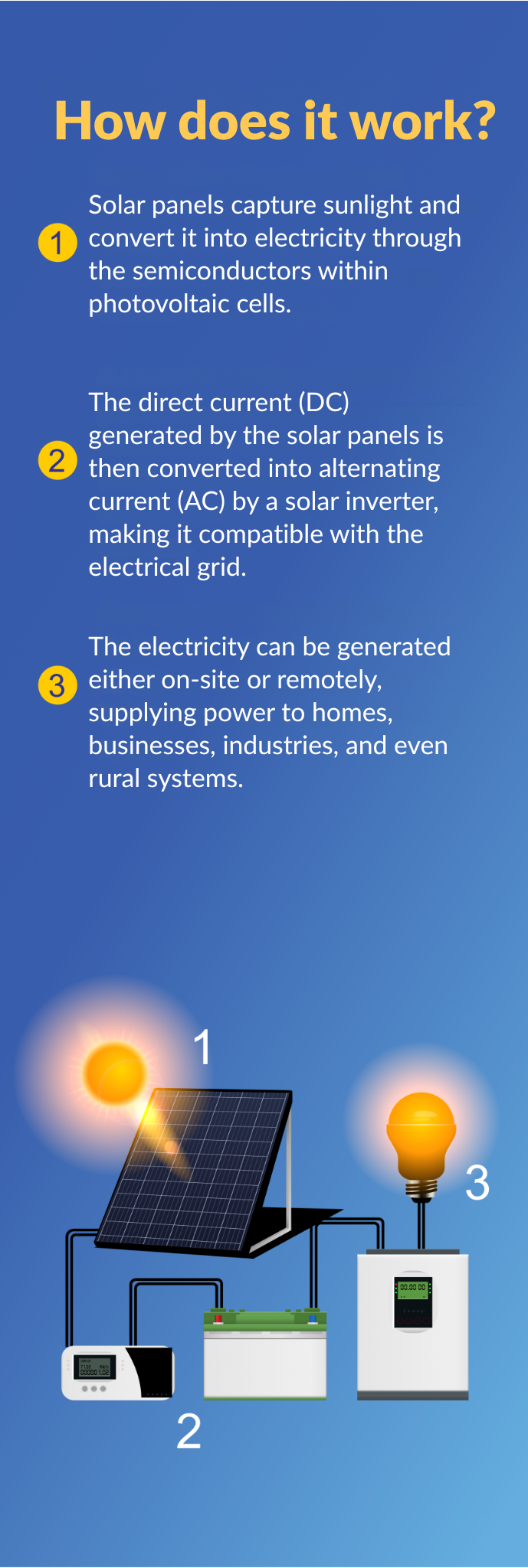
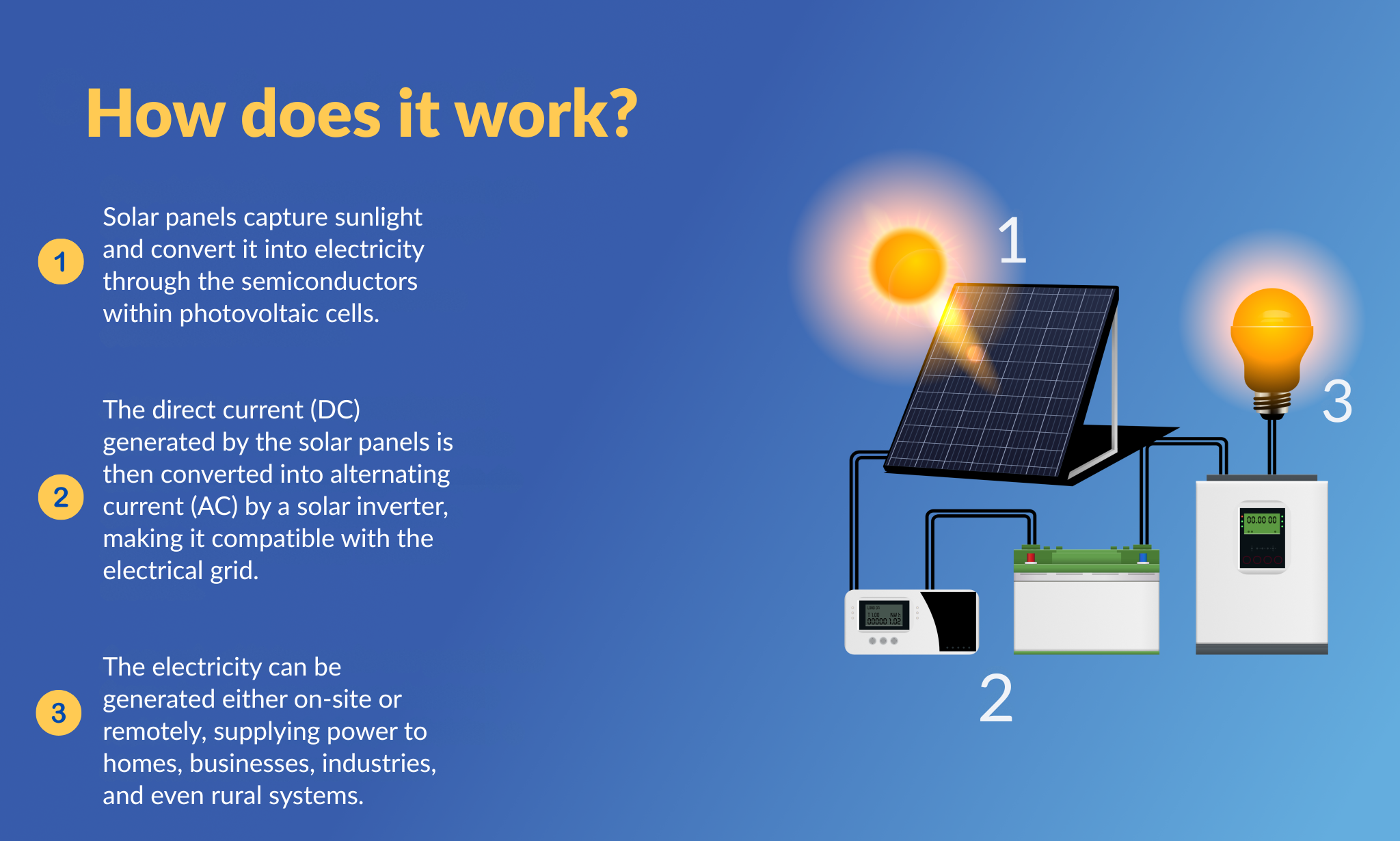
MODALITIES OF SOLAR PHOTOVOLTAIC GENERATION
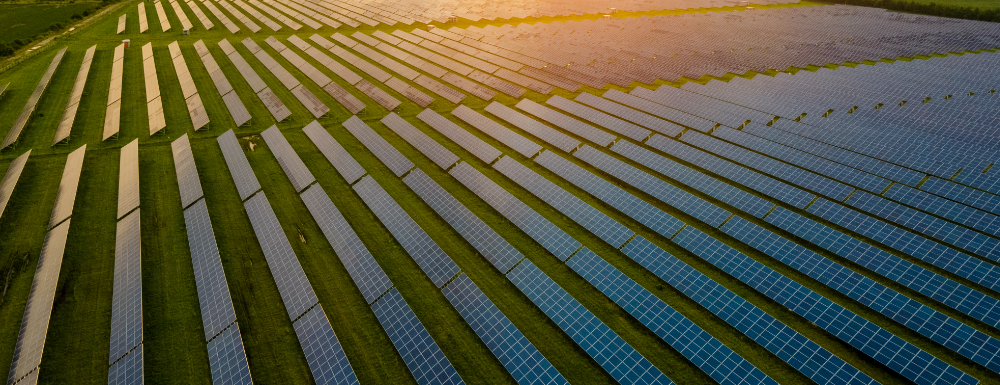
CENTRALIZED GENERATION
Centralized Generation (GC) refers to large-scale solar photovoltaic projects, typically located far from consumption centers and requiring transmission lines to deliver the electricity produced, that is sold either in the free electricity market, known as the Free Contracting Environment (ACL), or through auctions in the Regulated Contracting Environment (ACR).
ACL
Environment where generators, traders, free and special consumers buy and sell energy in open negotiations between buyers and sellers (bilateral contracts and power purchase agreements – PPAs), with the price agreed directly between the parties.
ACR
Environment where generators participate in electricity auctions, whose guidelines are established by the Ministry of Mines and Energy (MME), with contractual details structured by Aneel and bidding procedures carried out by the Electric Energy Commercialization Chamber (CCEE).
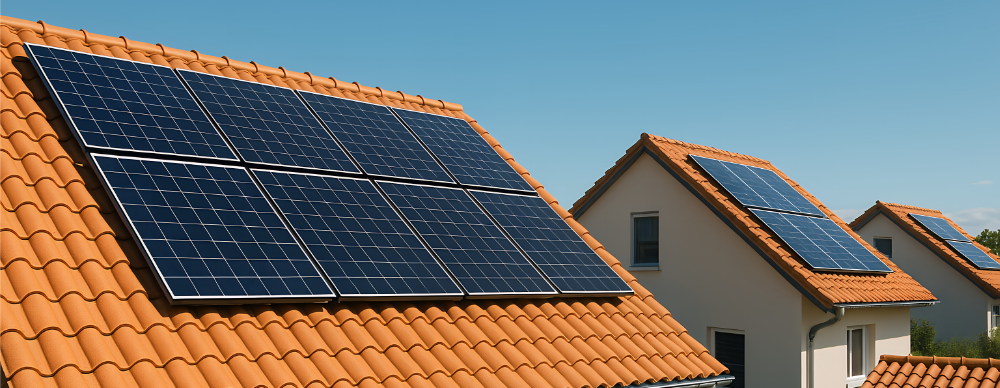
DISTRIBUTED
GENERATION
Distributed Generation (DG) involves small and medium-sized PV solar systems, generally closer to or next to consumption centers, whose energy is transported directly by the electricity distribution company’s network, with an installed capacity, in alternating current, of up to 3 MW, with or without electricity storage technologies, installed in places such as: homes, farms, businesses, public buildings, etc.
Distributed Photovoltaic Generation can also be applied in several other ways, such as:
Off-grid or Remote Photovoltaic Solar Systems
Rural
Solar
Systems
Low-Income Housing
Photovoltaic
Solar
Devices
When referring to grid-connected systems (on-grid), Distributed Generation includes four main modalities:
1
DG at the point of consumption (local generation):
The system is installed at the consumer unit, and the energy generated is used directly at the site.
2
Shared DG in Condominiums / Developments with Multiple Consumer Units (EMUC):
The energy generated is distributed among the condominium residents in proportions defined by the consumers themselves. It can also be used to supply the building’s common areas.
3
Remote Self-Consumption:
This modality allows the consumer to install a micro or mini-generation system at a different location from where they reside and use the energy credits generated to offset consumption and reduce the electricity bill (if it is within the same concession area).
4
Shared Generation (SG):
Multiple stakeholders—individuals or companies—form a consortium or cooperative and invest in a micro or mini-generation distributed system. The energy credits generated and injected into the grid by the system are shared among the group of consumers.


